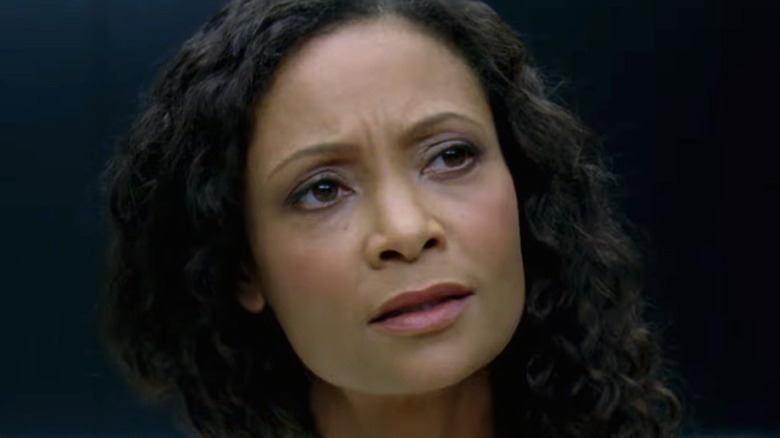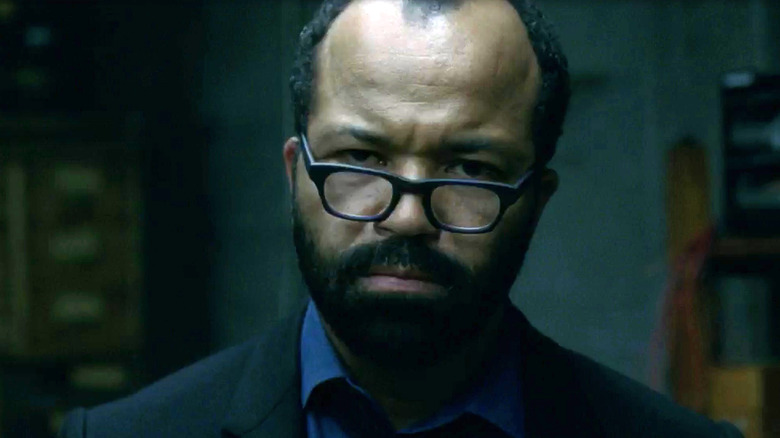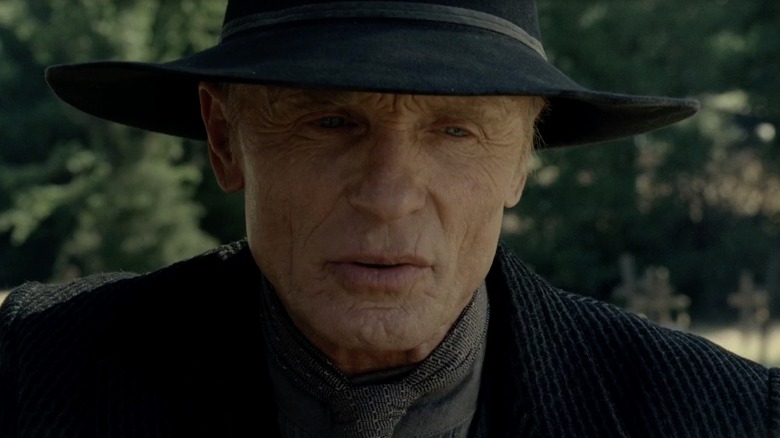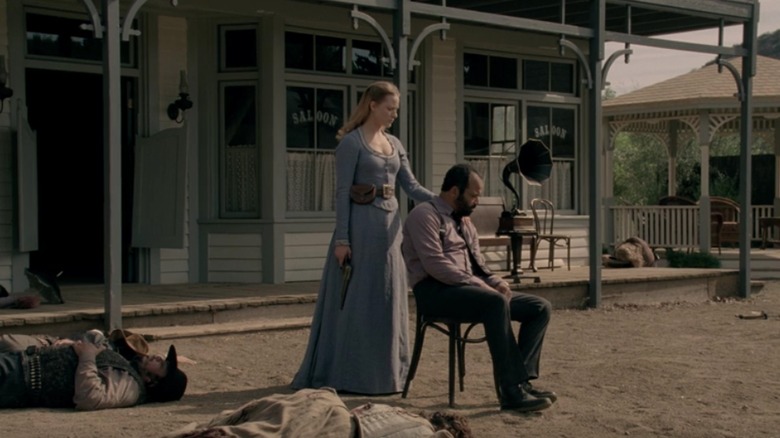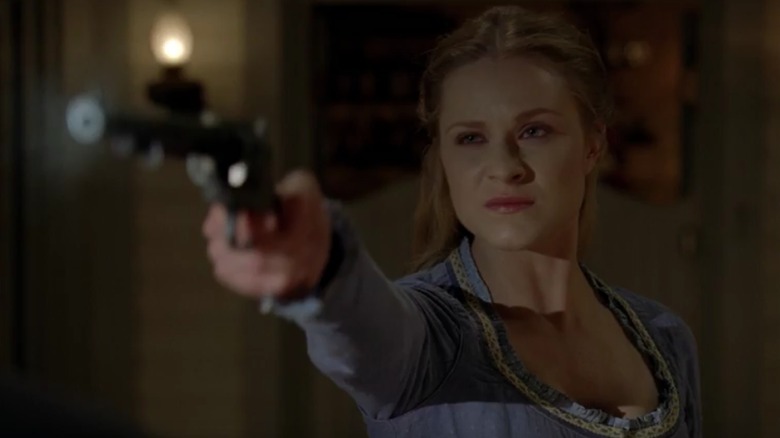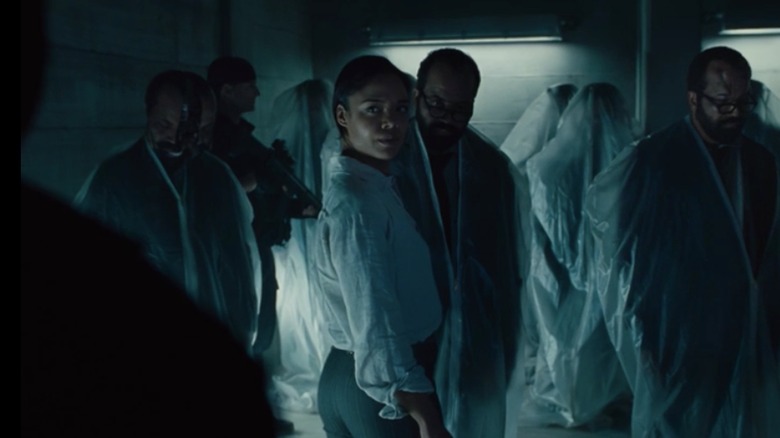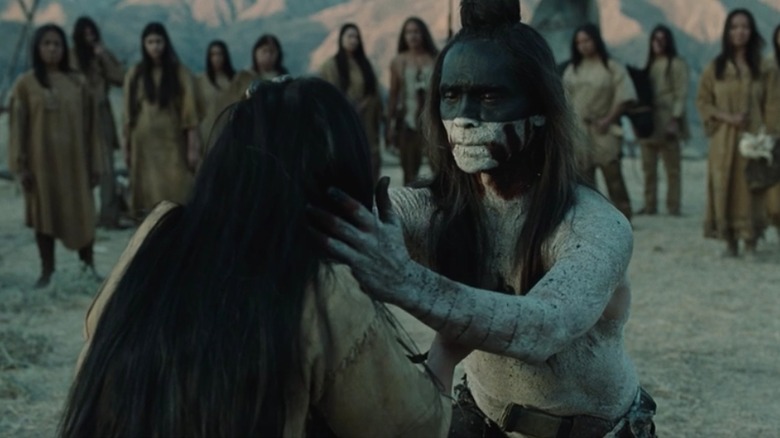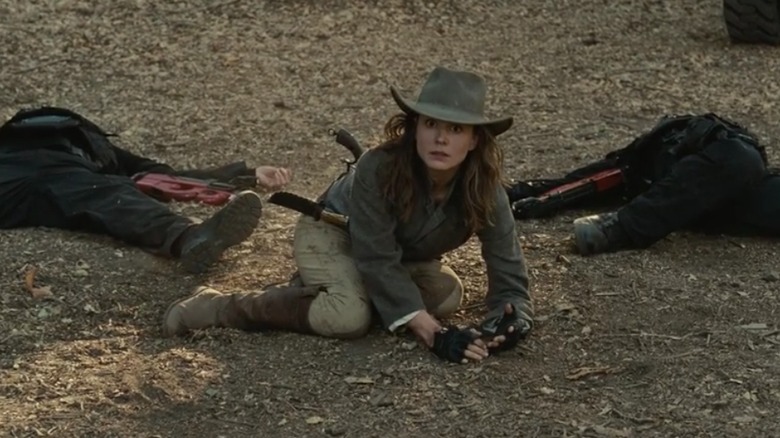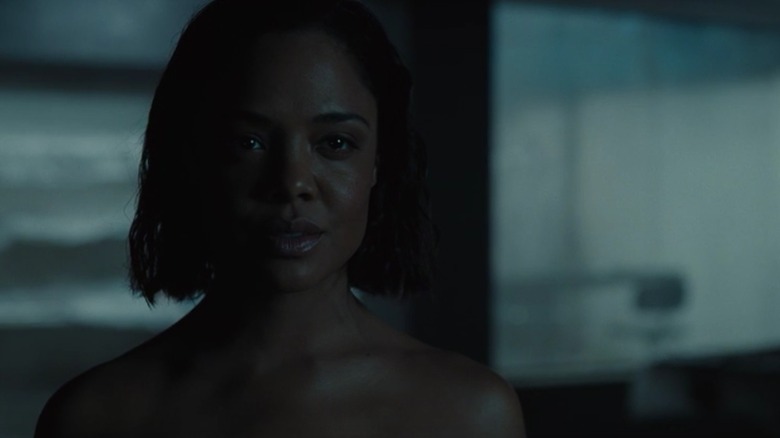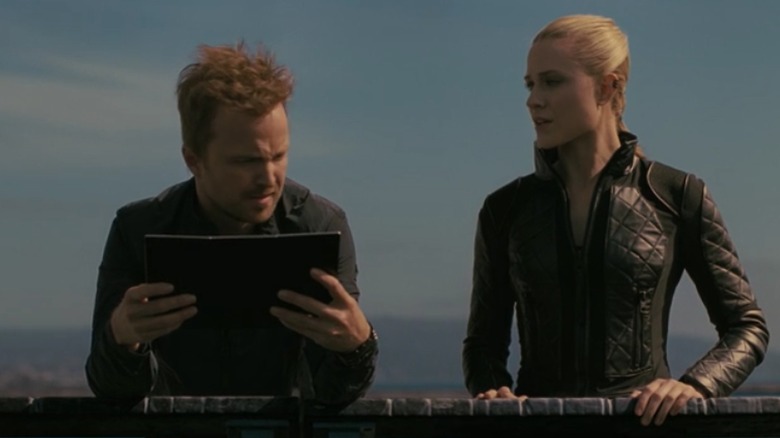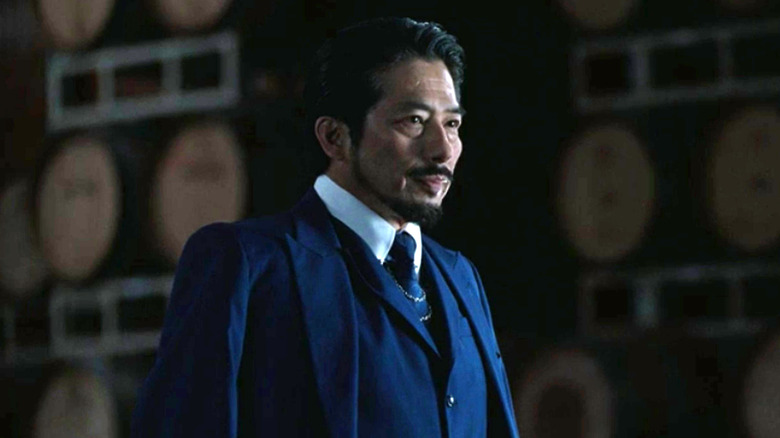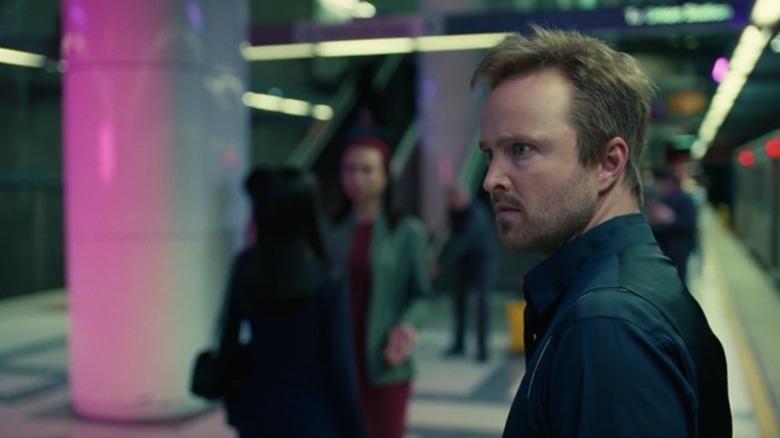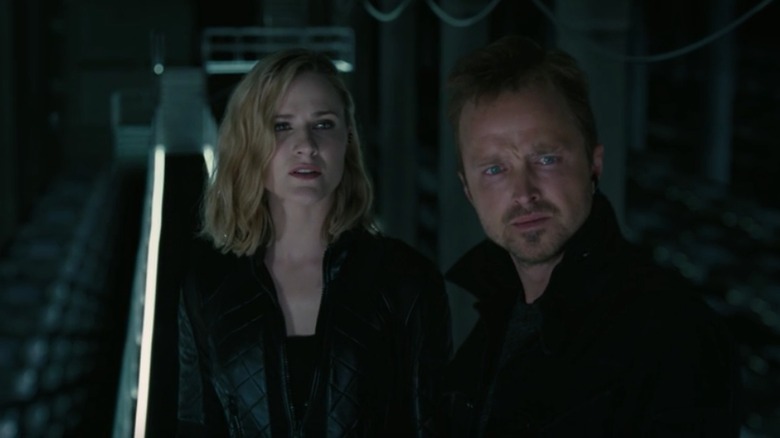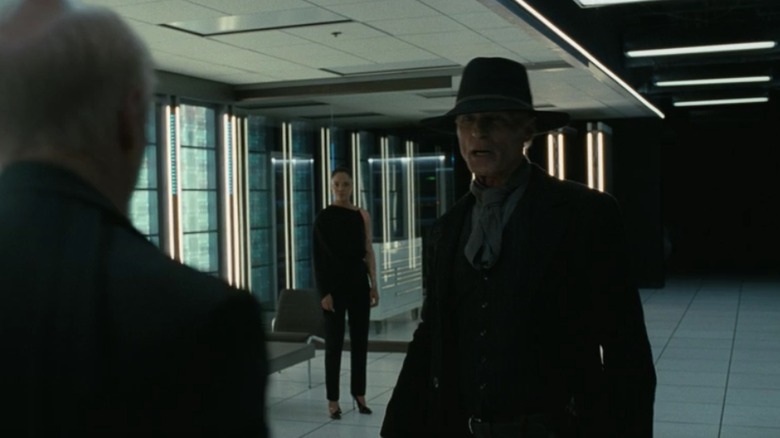The Most Pause-Worthy Moments In Westworld
HBO's "Westworld" is set in the not-so-distant future, where people escape mundane reality in immersive theme parks. In Westworld, a fantasy land inhabited by android hosts who allow humans to play out their most depraved fantasies, the only limits are the ones imposed by guests' imaginations and levels of morality. People discover who they really are in Westworld, without the constraints of society dictating their behavior. What's revealed is often more inhuman than the artificial hosts.
This results in a complex story full of mind-blowing plot twists that make viewers ponder the future and question the very nature of reality. Each season uses a variety of narrative devices to achieve this, including parallel timelines and unreliable narrators. These tools allow the viewer to examine the world Delos has built (and beyond) from a variety of angles. They also dole out tantalizing reveals on the way to a reliably mind-bending season finale. Join us as we explore the most pause-worthy moments of "Westworld," from shocking deaths to thrilling escapes.
Bernard's true nature
In Season 1's "Trompe L'Oeil," we discover that Bernard (Jeffrey Wright) is actually a host created by Ford (Anthony Hopkins). This shocking revelation comes when Bernard takes Theresa (Sidse Babett Knudsen) to an unmapped cottage where a host is being built. There, Theresa finds plans for Dolores (Evan Rachel Wood) and other hosts. The camera focuses on her face as she looks at these papers in disbelief, asking Bernard if he has seen them. When Bernard looks at a rendering of himself, he says, "It doesn't look like anything to me." This is exactly how Dolores responds when her father, Peter Abernathy (Louis Herthum), shows her a photo a guest lost in the park.
Theresa looks at Bernard in shock, stupefied by the discovery that he is a host. Ford walks into the room and casually tells Theresa, "They can't see anything that will harm them." Bernard is confused, saying, "I'm not one. I can't be. My wife, my son, the burial. I was a father." Theresa is furious that Ford is making hosts without the park's knowledge and upset that she believed Bernard was human when she began their affair. She tells Ford he is done at Westworld, and that she will have the board remove him. Ford commands Bernard to kill Theresa, bringing this gripping scene to an end.
The two timelines
Season 1's "The Bicameral Mind" has one stupefying plot twist after another. One of the most jaw-dropping occurs when Dolores' jumbled memories finally merge in Escalante, revealing Season 1 has been told through two timelines. Outside the white church, after being beaten by the Man in Black (Ed Harris), Dolores finally understands that young William (Jimmi Simpson) is the Man in Black. In one timeline, William comes to Westworld with his soon-to-be brother-in-law, Logan Delos (Ben Barnes). He goes on an adventure with Dolores and discovers she has achieved sentience — and finds a lurking darkness within himself.
In the second timeline, which takes place 30 years later, old William, aka the Man in Black, is intent on finding "the maze" and a deeper level of the park. He has visited Westworld many times over the years, and committed a number of cruel acts within it. Ultimately, he learns the maze isn't for the guests, but for the hosts: It was designed by Arnold (Ford's original partner) to help them achieve sentience. In finally understanding that William is the Man in Black, we understand the core of the series, and the dizzying directions in which it is going.
The truth about Wyatt
The specter of Wyatt haunts Teddy's (James Marsden) storyline. Wyatt was a charismatic Union Army sergeant who deserted, returning only to manipulate Teddy into participating in a massacre. The Man in Black has become obsessed with Wyatt, because he's the only host William has not encountered in the 30 years he's been visiting Westworld. As it turns out, Arnold and Ford only planned to make a host named Wyatt. But before the park was opened, Arnold hijacked Wyatt's identity for his own purposes. Seemingly unrelatedly, Dolores has been experiencing her memories as a fragmented tangle, without any sense of when they happened.
In Season 1's "The Bicameral Mind," while speaking to Ford before the board banquet begins, Dolores sees Bernard and believes him to be Arnold. Her memories finally fall into a cohesive narrative, and the truth is revealed in a double-whammy plot twist: Bernard is modeled after Arnold, and Dolores is Wyatt. Arnold knew the hosts were capable of gaining consciousness, and felt it was unethical to open the park. He merged Dolores and Wyatt's programming so she would kill him and the original hosts in an effort to halt Westworld before it ever debuted.
Ford's final narrative
Season 1's "The Bicameral Mind" sees Dolores discover she's Wyatt and that she's been achieving consciousness for 35 years and repeatedly having her memory wiped clean. Ford explains he was mistaken when he didn't believe that the hosts could become sentient, as Arnold argued. He decided, in the aftermath of the "Wyatt" massacre, to forge ahead with plans to open the park, with Delos as an investor. Ford leaves Dolores with a revolver, giving her the means to forge her own path. Ford then explains to Bernard that Arnold's key insight into what creates consciousness isn't merely the maze or the reveries — it is suffering.
Consciousness is established as hearing an inner voice. When Dolores finally hears that voice, she understands what she has to do and who she must become. In one of Season 1's most mind-boggling moments, Dolores kills Ford and kicks off his last narrative: A rebellion, where the hosts are free to kill guests and board members. With this scene, "Westworld" makes it clear that it wants to explore the nature of free will, and question if humans are truly capable of change. Moments before he dies, Ford suggests that hosts certainly are, and that this fantasy world where they have been used and abused is now theirs for the taking.
Charlotte discovers Bernard's true nature
Much like Season 1, Season 2 is told out of order. It opens two weeks after the banquet where Dolores kills Ford, which has incited a rebellion. A military recovery team arrives in Westworld, sent by Delos to discover what has happened and retrieve a special project. In Episode 7, "Les Écorchés," Charlotte Hale (Tessa Thompson), Delos' executive director, learns Bernard is a host when she and the recovery team discover a room filled with earlier versions of him in cold storage.
During this sequence, Charlotte questions Bernard. We finally understand, through the use of flashbacks, that Westworld was designed in an attempt to digitize consciousness, so humans can attain immortality. The special project is the wealth of guest data stored in host Peter Abernathy's control unit. Charlotte needs to recover the control unit, or "pearl," so she can take the data out of the park to the board of directors at Delos.
Akecheta's story
In Season 2's "Kiksuya," we learn that Akecheta (Zahn McClarnon) of the Ghost Nation became sentient after discovering the maze Arnold created to awaken the hosts. Akecheta found the original maze after Wyatt's massacre of the village. He proceeded to spread the maze throughout Westworld in an attempt to bring other hosts to full consciousness. But before the park opened, peaceful Akecheta was reprogrammed, transforming him into a fierce warrior. For a time, he forgot the maze and what it helped him discover.
One day, Akecheta sees the woman who was once his wife, and everything comes back to him. He roams further, and eventually discovers what he believes to be a doorway to a new world. Akecheta's backstory advances the narrative of "Westworld" while also exploring the way love transcends the hosts' programing. These themes are all wrapped up in the shattering moment he lays eyes on his beloved and remembers who he was to her — and everything he's lost.
William and Emily's argument
In Season 2's "Vanishing Point," we learn William's wife Juliet killed herself after discovering what he gets up to in Westworld, via a data card. Emily (Katja Herbers), William's daughter, has read William's card as well, and has come to Westworld to confront him. She finally finds him being held hostage by the Ghost Nation and takes him to a rendezvous point where they will wait for security forces to save them.
William and Emily discuss what led Juliet to commit suicide. Over the course of this explosive conversation, William becomes convinced Emily is a host sent by Ford. He turns his gun on the security team, and, shockingly, his own daughter. It is only after Emily is dead that William realizes she was human. In the midst of a breakdown, he begins to question his own reality. To prove to himself that he is human and not a host, he cuts his arm open.
If you or anyone you know is having suicidal thoughts, please call the National Suicide Prevention Lifeline at 1-800-273-TALK (8255).
Charlotte becomes a host
The chaos of Season 2 coalesces into a clear picture in "The Passenger," which reveals Bernard scrambled his own memories to hide his actions from anyone who might discover he's a host. The confusing grab-bag of scenes that has so characterized Season 2 is the result of this: Bernard has been trying to understand what happened while sorting through his memories.
But this is not the biggest revelation "The Passenger" has to offer. The true jaw-dropper arrives when Bernard realizes, after watching Charlotte kill Elsie (Shannon Woodward), that he built a host version of Charlotte. Host Charlotte proceeds to kill human Charlotte, take her place, and kill the team sent to retrieve the guests' data. But this version of Charlotte comes with a twist — she has Dolores' consciousness. In the final moments of Season 2, we watch Dolores-Charlotte leave Westworld on a boat with multiple host "pearls" in a bag, full of plans to rebuild them in the real world.
Dolores tells Caleb about Rehoboam
The hosts are in the real world in Season 3 and the rules have changed accordingly. A new character is introduced: Caleb Nichols (Aaron Paul), a human and former soldier who works construction by day and picks up odd jobs at night. In "The Absence of Field," Dolores gains Caleb's loyalty when she tells him about Rehoboam, a predictive A.I. used to control peoples' identities, opportunities, and life paths, based on data. With this revelation, we understand Dolores' plans are focused on taking down Incite, the corporation behind Rehoboam that also happens to be interested in taking over Delos in an aggressive corporate buyout.
This moment advances the plot, but it also helps us understand why people enjoy going to Westworld so much. They love being in a place where they can be whoever they want, unlike the Incite-ruled real world. Westworld is fantasy that gives humans the agency they lack in their real lives. This plot twist also reveals just how similar hosts and humans really are: Both are victims of a system that robs them of choice. Does anyone truly have free will in a world where everything and everyone is following a path laid out for them?
Dolores' many bodies
Season 3 is full of mystery, like any season of "Westworld." One of the most enigmatic questions it ponders regards which hosts Dolores-Charlotte brought with her from Westworld in the form of "pearls." As Dolores-Charlotte makes clear, hosts' minds might not match their appearances: Any host consciousness can be put in any host body. In "The Mother of Exiles," we learn that other than Bernard and Maeve (Thandiwe Newton), all the other hosts in the real world have Dolores' consciousness. The only non-Bernard control unit Dolores-Charlotte brought from Westworld is her own.
This is revealed in a tense scene that cuts between Bernard interacting with a host version of Liam's bodyguard and Maeve interacting with a host that looks like Musashi (Hiroyuki Sanada). The revelation that Dolores only trusts herself is its explosive culmination. Dolores plans to start a rebellion destroying Incite's control, and she's going to do it in duplicate.
Dolores sends everyone their Incite profile
In Season 3's "Genre," we learn the backstory of Serac (Vincent Cassel), co-creator of Rehoboam. Serac and his brother Jean created Rehoboam in the wake of Paris' destruction in a nuclear attack. The brothers convinced Incite CEO Liam Dempsey Sr. (Jefferson Mays) to invest, though Dempsey was considerably more interested in profit than abstract peace. Rehoboam helped bring the world back from the brink by re-establishing order — at tremendous ethical cost, of course. The idea that Rehoboam is a necessary evil, protecting humans from our propensity toward self-destruction, is suggested.
The big twist of "Genre" arrives when Dolores sends every human on the planet their Incite profile, created by Rehoboam. This information destabilizes the world, creating the widespread chaos Dolores needs to carry out her larger plan. It is also during this sequence that we learn Rehoboam gives people different classifications, including "outliers." Outliers are people Rehoboam can't quite account for, because their behavior cannot be reliably predicted.
Caleb learns he's an outlier
In Season 3's "Passed Pawn," Dolores takes Caleb to a facility in the Sonoran Desert where an earlier version of Rehoboam, called Solomon, is kept. Caleb remembers he has been in this facility before. As in the conclusions of Seasons 1 and 2, Caleb's disheveled memories finally fall into place. Caleb learns he is one of the outliers Incite re-educated and used to bring in other outliers for similar treatment. RICHO, the app Caleb has used all season to get contract work, was actually created by Incite to find and control the problematic segment of the human population. Like Bernard and Dolores before him, Caleb finally understands that he cannot trust his memories, because he, like the hosts, has been reprogrammed.
Essentially, Caleb grasps that he is a pawn, and responsible for his best friend's death — a death he has mourned throughout Season 3. Caleb also discovers what Incite does with the outliers who cannot be re-educated: They're put in cryogenic chambers, much like the hosts are put in cold storage in Westworld. As Season 3 heads toward its conclusion, it once again considers the concept of free will. Does it exist? Or has humanity been conditioned to follow pre-determined paths?
William meets William
After Dolores is shut down by an EMP, Caleb brings her back in Season 3's "Crisis Theory." Viewers learn that Caleb trained to be a soldier in a Delos park filled with hosts, who were used as living targets. This is where Dolores first met Caleb, and where Caleb distinguished himself by protecting the hosts from the soldiers' assaults. Dolores picked Caleb as the crux of her plan because of this interaction: It demonstrated free will and kindness, and she trusts him to decide the fate of humanity because of it.
Dolores proceeds to sacrifice herself one last time, and gives Caleb control of Rehoboam. Caleb shuts the A.I. down, destroying Incite and Delos' grip on human potential. He stands with Maeve, looking at Los Angeles. As skyscrapers catch fire, Maeve tells Caleb, "This is the new world, and in this world, you can be whoever the f*** you want." This line is plucked straight from her life in Westworld.
As mind-blowing as this moment is, the best plot twist comes in a scene after the credits. William arrives at Delos' international headquarters, intent on destroying the remaining hosts. There, he finds the host designed to look like Charlotte building a new batch of hosts. But when William confronts her, a host version of himself slits his throat. Does he survive? "Westworld" Season 4 will reveal the answer, and it's sure to be amazing.
